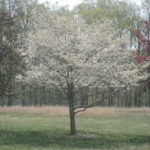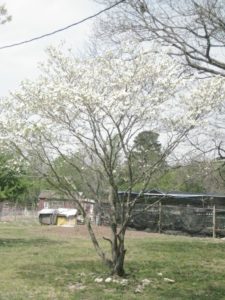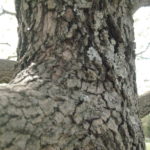
Family Project: Identifying Dogwood Trees in the Woodland
We have two beautiful Dogwoods in our front yard, one nestled between the outbuildings behind our house, and dozens scattered throughout the woods that border the back of our property.
 They are not only aesthetically beautiful, but also very well-mannered.
They are not only aesthetically beautiful, but also very well-mannered.
Requiring little to no input or maintenance, they enhance the overall landscape we are aiming for.
 Given their medium size and their preference for dappled shade, they fill a void in the three-dimensional space without being problematic, providing dappled shade themselves.
Given their medium size and their preference for dappled shade, they fill a void in the three-dimensional space without being problematic, providing dappled shade themselves.
While the fruit of this species is not meant for human consumption, the trees provide fodder for the birds and animals in their natural habitat as well as our own domesticated herds.
 I imagine there are other benefits of the Dogwood by way of its bark, branches, leaves, root and berries that I am not even aware of yet, such as possible healing properties or resource material for particular sorts of construction or fuel.
I imagine there are other benefits of the Dogwood by way of its bark, branches, leaves, root and berries that I am not even aware of yet, such as possible healing properties or resource material for particular sorts of construction or fuel.
Did you know…
The Flowering Dogwood is Virginia’s State Tree and State Flower (and the name of my first elementary school in New Jersey 😉 ).
In an attempt to better manage the trees on our property for both short- and long-term benefit, I think it’s important for our kids to understand what we have, and why we’re doing what we’re doing.
So yesterday, I took the kids out back to our woods equipped with water bottles, hats and marking materials, and had my husband explain the day’s project.
Marking the Dogwoods
The Dogwoods are in full bloom this time of year making them easy to identify in a sea of trees.
We usually get our firewood from the woods and like to graze our animals back there when the nuts fall. My husband wants to convert at least a portion of the woods into a silvopasture over time, so we need to start selecting the kind of trees we want to keep and/or cut down.
“Silvopasture (Latin, silva forest) is the practice of combining forestry and grazing of domesticated animals in a mutually beneficial way.” – Wikipedia
We never want to cut down a Dogwood. Since they are fragile compared to some of the trees we want to fell, we want to make sure they stand out to us when the time comes to harvest. Our biggest concern is having them smashed by falling trees, and then of course, we don’t want to accidentally cut one down.
 So, with a spool of plastic flag ribbon and a pair of scissors in hand we set out to identify and tie white ribbons around each Dogwood.
So, with a spool of plastic flag ribbon and a pair of scissors in hand we set out to identify and tie white ribbons around each Dogwood.
We started by paying special attention to one Dogwood, taking note of its various characteristics:
- white flowers
- rough bark
- spindling and spreading branches
- medium height
Personally, I looked for the white flowers to know where to turn to next, whereas my Wiggle Son #1 focused on the bark of the trees to guide his next move. I find it is much easier to identify a particular tree when you focus on one variety at a time.
After about 30 minutes having each of us spread out to canvass the acreage and marking all that we saw, we gathered in one spot to talk about our observations.
Then later in the day, I had each child write down what we did in their WiggleCulture Journals and identify three characteristics of the Dogwood.
This was the first time we did something like this, and they didn’t know I would be sharing their work online like this. My primary objective was to have them simply record what they learned, however they felt most comfortable, and not be hindered by doing it perfectly.
I thought it was neat to see the variety of things they individually picked up on.
Preparing the Generations to Come
In July 2004 we purchased our property from my grandparents, Warren and Margaret Beach, who bought and maintained it throughout the late 1960s, 70s and 80s. Unfortunately, I didn’t know what their long-range goals were when they actively managed the place.
When we moved in, my grandfather had been deceased for over a decade and my grandmother was not in any condition to continue the property’s upkeep. Most of the land had gone many years neglected. All I had to draw upon were memories from my childhood visits and sadly, I was not much of an outdoor girl to take note of what went on with the land at that time.
We’ve been living here now for over a decade. And although my husband has been working the land for most of our time here, he had very limited knowledge in how to properly manage the land most effectively. He came from a commercial landscaping perspective, having spent most of his life in the city, as opposed to that of an holistic land steward, so he didn’t always make the wisest of choices along the way.
Now, however, he is taking better care in working towards a more long-term objective in providing a sustainable environment not only for us in the present, but also for our future generations.
And I, as a middle-aged woman, having recently taken more interest in the land around me, recognize the need not only to physically work alongside him to achieve this objective, but also to intentionally share this knowledge with our children.
Therefore, I aim to conduct lessons like these with my children on a regular basis, particularly relating to our land and animals so they’ll be better prepared for the management of their inheritance.










